Lombok is a beautiful island located in Indonesia, known for its stunning beaches, volcanic landscapes and rich cultural heritage. The island is also home to a diverse range of bird species, making it a popular destination for bird watchers and nature enthusiasts.
With over 180 bird species found in the region, including several endemic species, Lombok offers a unique opportunity to witness the natural beauty and biodiversity of Southeast Asia. From majestic eagles and owls to colorful kingfishers and parrots, Lombok’s birdlife is truly a sight to behold.
In this article, we will explore the fascinating world of birds in Lombok, their habitats, behaviors and conservation efforts.
1. Lesser Coucal
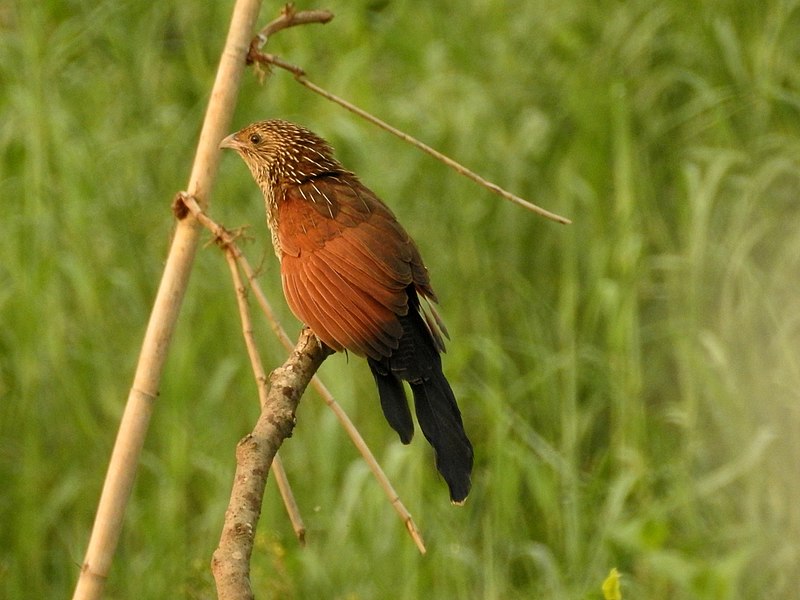
The Lesser Coucal is an iconic bird of the Cuculidae family. It has a wide distribution range and can be found in wetland habitats with plenty of grass, trees and shrubs.
This species stands out due to its relatively small size compared to other cuckoos as well as their less prominent bills and pale shaft streaks on the feathers of their heads and backs.
They have long claws which they use for perching or catching prey while hunting, making them efficient predators.
The calls made by these birds are quite distinct from those heard from other members of this genus – it sounds like two stones being knocked together.
All in all, this unique species is truly fascinating.
Scientific classification:
| Kingdom | Animalia |
| Phylum | Chordata |
| Class | Aves |
| Order | Cuculiformes |
| Family | Cuculidae |
| Genus | Centropus |
| Species | C. bengalensis |
Also Featured In: Common Birds in India, Birds that Live in Tamil Nadu
2. Edible-Nest Swiftlet
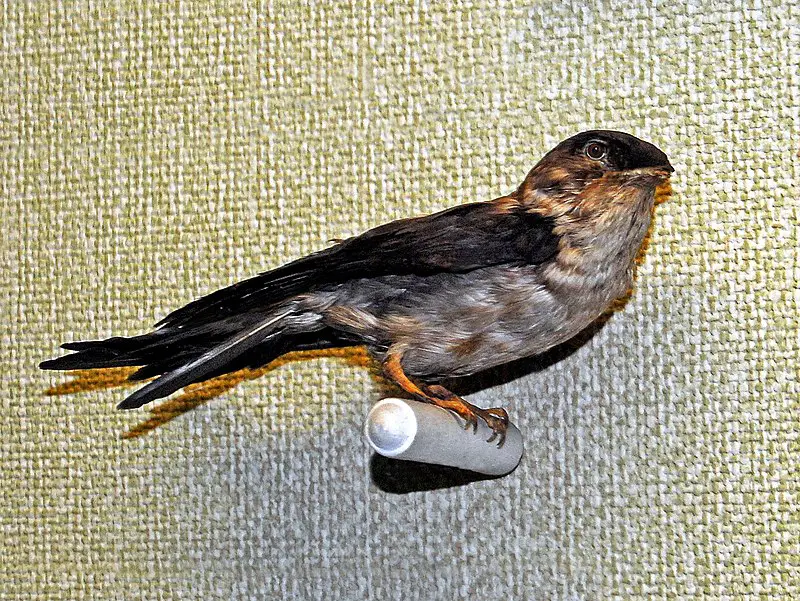
The Edible-nest swiftlet is a small bird found in Southeast Asia, belonging to the Swift family.
It has an opaque and whitish nest which is made of solidified saliva, making it one of its most prized features as it forms the main ingredient for bird’s nest soup – a Chinese delicacy.
Its body length ranges from 14cm (5.5in) and can weigh up to 13g(0.45oz). They feed on insects or flying prey by catching them mid-air with their beaks rather than perching on branches like traditional birds do.
Their nests are usually built in dark corners high above ground level such as caves or gaps between rocks where they lay two eggs at once before hatching them after 18 days incubation period .
The male edible-nest swiftlets also produce special sounds using their wings during courtship season which helps attract females during mating season.
Scientific classification:
| Kingdom | Animalia |
| Phylum | Chordata |
| Class | Aves |
| Order | Apodiformes |
| Family | Apodidae |
| Genus | Aerodramus |
| Species | A. fuciphagus |
Also Featured In: Birds of Myanmar,
3. Rainbow Bee-Eater
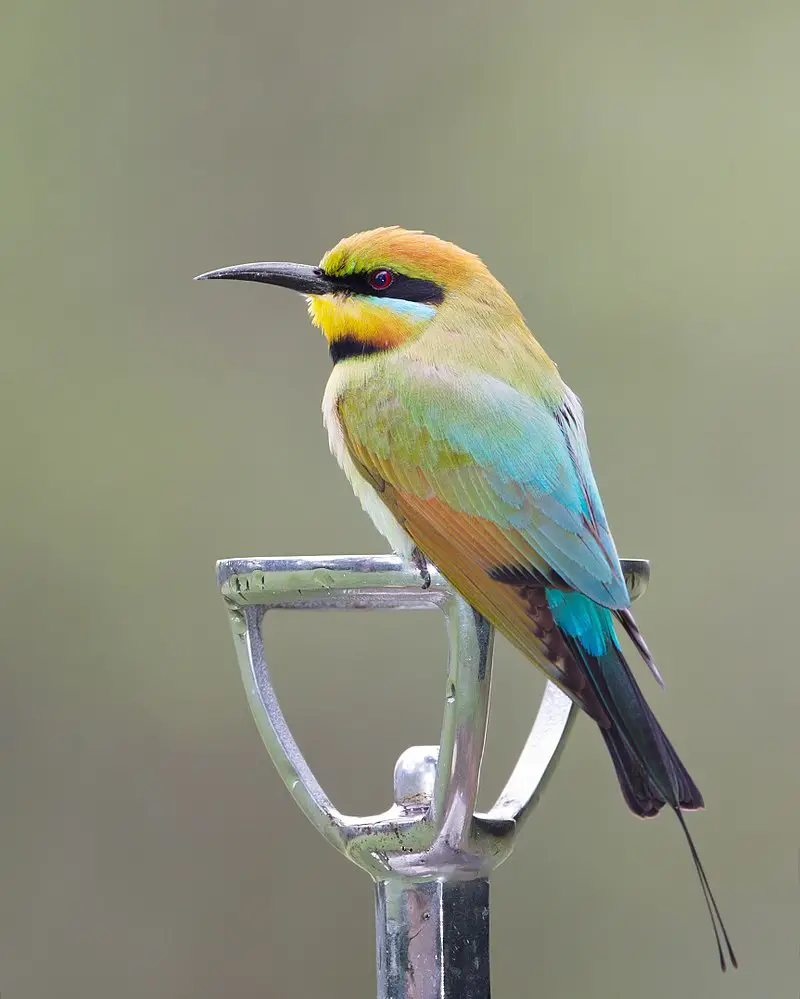
The Rainbow bee-eater (Merops ornatus) is a delightful near passerine bird belonging to the bee-eater family Meropidae.
It is found exclusively in Australia, making it one of only two species of its kind throughout the world; its closest relative being located in Southern and Eastern Africa – the olive bee-eater (Merops superciliosus).
Its stunning plumage features a unique palette of colours including shades pinkish reds, blues, greens and yellows which make for an impressive display when seen up close.
Due to their diet consisting mainly on bees and other insects they have adapted specialised beaks with serrated edges that allow them to easily capture their prey mid flight.
A truly remarkable sight indeed.
Scientific classification:
| Kingdom | Animalia |
| Phylum | Chordata |
| Class | Aves |
| Order | Coraciiformes |
| Family | Meropidae |
| Genus | Merops |
| Species | M. ornatus |
Also Featured In: Most common birds in Australia, Birds that Charles Darwin Studied
4. Black-Naped Monarch
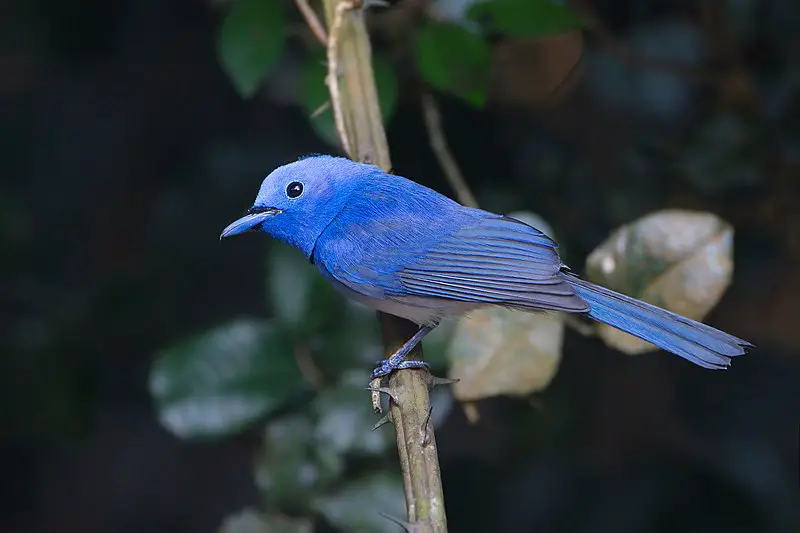
The Black-naped Monarch is a beautiful and agile passerine bird native to Southern and South East Asia.
With its distinct black patch on the back of it’s head, this small but strong species stands out among other birds in the area.
The male has vibrant blue plumage with an elegant narrow black half collar (“necklace”) which makes him even more attractive.
Females are comparatively duller with olive brown wings and light yellowish underparts which helps them blend into their environment better for camouflage purposes.
These birds feed mainly on insects, spiders and fruits making them beneficial as they help reduce pests while also providing nutrients to local vegetation by dispersing seeds from fruit consumption.
Scientific classification:
| Kingdom | Animalia |
| Phylum | Chordata |
| Class | Aves |
| Order | Passeriformes |
| Family | Monarchidae |
| Genus | Hypothymis |
| Species | H. azurea |
Also Featured In: Singapore Birds, Gujarati Birds
5. Bridled Tern
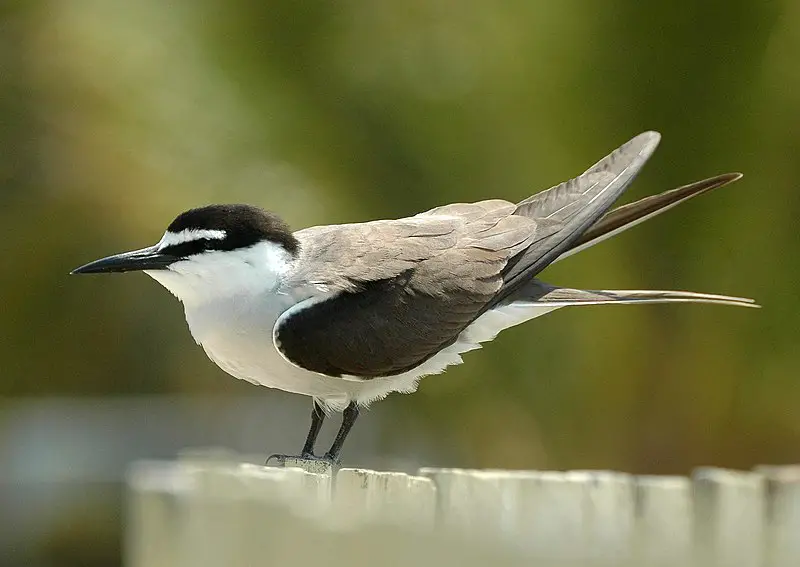
The Bridled Tern is a medium-sized seabird of the family Laridae, found in tropical oceans. It has an impressive wingspan of 77–81 cm and measures 30–32 cm in length – similar to that of the Common Tern.
Its scientific name originates from Ancient Greek; Onux meaning “claw” or “nail”, and Prion, which translates as “saw”. The specific anaethetus means ‘senseless’ or ‘stupid’.
These birds are elegant flyers with greyish brown upperparts and white underparts when they take off into flight, while their head appears black on top but turns to white below the eyes with a thin line between them.
Scientific classification:
| Kingdom | Animalia |
| Phylum | Chordata |
| Class | Aves |
| Order | Charadriiformes |
| Family | Laridae |
| Genus | Onychoprion |
| Species | O. anaethetus |
Also Featured In: Oman Birds, British Virgin Islands Birds You Need to See
6. Metallic Pigeon
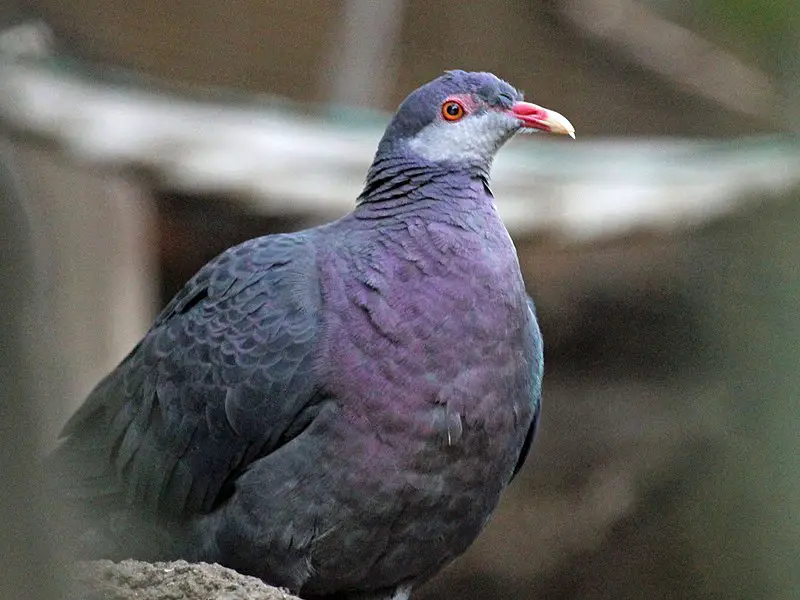
The Metallic Pigeon, or white-throated pigeon, is a medium-sized bird of the family Columbidae. Measuring up to 37 cm in length, it boasts an array of beautiful colors and features.
It has a dazzling iridescent purple and green crown, black wing and uppertail coverts with yellowish red eyes surrounded by red orbital skin around each eye.
Its beak is yellow while its chin and ears are covered with either grey or white feathers.
The underbelly shines brightly in chestnut or glossed purple shades for added beauty when flying about its natural habitat.
Lastly, this spectacular species sports purplish feet which act as perfect complements to their already colorful plumage.
Scientific classification:
| Kingdom | Animalia |
| Phylum | Chordata |
| Class | Aves |
| Order | Columbiformes |
| Family | Columbidae |
| Genus | Columba |
| Species | C. vitiensis |
Also Featured In: Timor-Leste birds, Birds of New Caledonia
7. Short-Tailed Starling
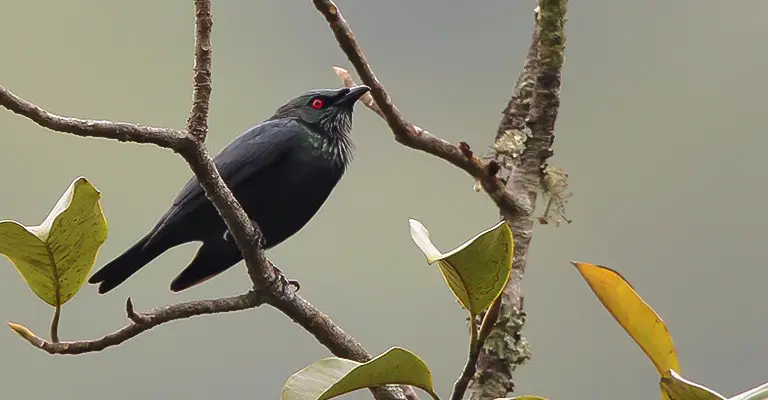
The Short-tailed starling is a species of bird from the Sturnidae family, found in Indonesia and the Philippines. It has black plumage with yellowish underparts, pink bill, and short tail feathers.
Its natural habitats are humid lowland forests and moist montane forests. These birds often form large flocks to feed on fruits scattered around their habitat or roost overnight at communal sites near trees or shrubs.
They also visit gardens for water baths during hot afternoons as well as take dustbaths which helps them keep parasites away from their body feathers while preening themselves afterwards.
In addition they have been known to raid crops such as rice fields if food resources become scarce due to human activities like deforestation or overhunting.
Scientific classification:
| Kingdom | Animalia |
| Phylum | Chordata |
| Class | Aves |
| Order | Passeriformes |
| Family | Sturnidae |
| Genus | Aplonis |
| Species | A. minor |
8. Lesser Frigatebird
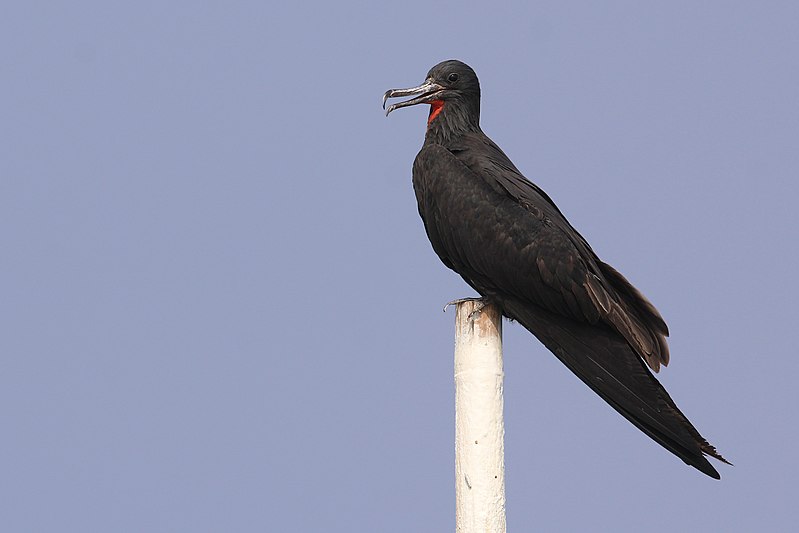
The Lesser Frigatebird is a seabird of the Fregatidae family and is known to be the smallest species in this group. It has brownish-black plumage, long narrow wings, and a forked tail.
This bird inhabits tropical and subtropical regions across the Indian Ocean, Pacific Ocean as well as off Brazil’s Atlantic Coast.
It feeds on fish taken from surface water or by plunge diving while flying low over shallow waters.
Its primary breeding grounds are located around islands with steep cliffs where it builds its nests out of twigs and grasses high up near ledges or crevices.
The lesser frigatebird can live for about 25 years due to their strong aerodynamic abilities which allow them to glide through air currents effortlessly thus conserving energy during flights that last days at a time.
Scientific classification:
| Kingdom | Animalia |
| Phylum | Chordata |
| Class | Aves |
| Order | Suliformes |
| Family | Fregatidae |
| Genus | Fregata |
| Species | F. ariel |
Also Featured In: Mauritius birds, Birds that Live in the Ocean
9. Black-Naped Tern
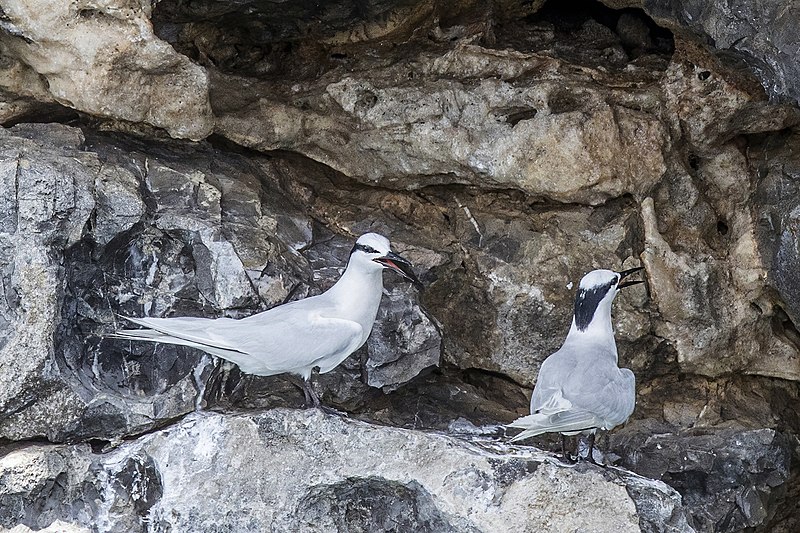
The beautiful Black-naped Tern is a seabird found in tropical and subtropical areas of the Pacific and Indian Oceans.
These terns measure around 30 cm long, with a wing span of 21 to 23 cm, black beaks and legs, yellow bill tips, long forked tails and white faces.
The breast has grayish-white feathers that extend down its back – forming an elegant nape hence their name.
They are rarely seen inland but they can stay close to coastal waters or even venture further out depending on seasonal changes.
Their diet consists mainly of fish which they hunt from above by hovering before plunging into the sea at high speed after prey. They also feed on crustaceans sometimes too.
All in all these birds have an interesting lifestyle; incredibly graceful when airborne yet ferocious hunters underwater making them quite a sight.
Scientific classification:
| Kingdom | Animalia |
| Phylum | Chordata |
| Class | Aves |
| Order | Charadriiformes |
| Family | Laridae |
| Genus | Sterna |
| Species | S. sumatrana |
Also Featured In: Maldives birds, Birds You’ll Find in the Marshall Islands
10. Greater Crested Tern
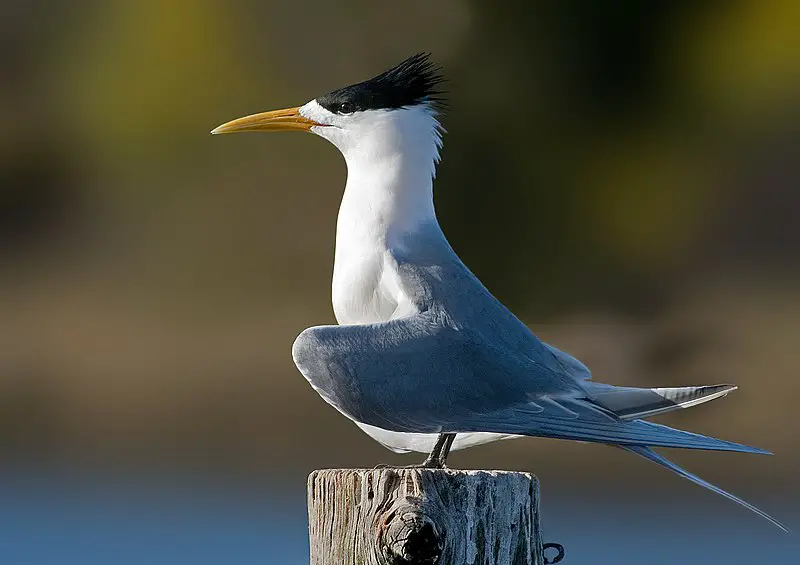
The Greater crested tern is a large bird of the family Laridae, found in tropical and subtropical regions across the Old World.
It has five subspecies which breed from South Africa to Australia, before migrating away for winter.
The distinctive crest feathers on its head give it its name and set it apart from other species like gulls or skuas.
They have wide wingspans that allow them to fly swiftly over oceans or coasts with ease – they are known as swift terns because of this.
The greater crested tern feeds mainly off fish caught at sea by plunge-diving into waters up to 10m deep; an impressive feat indeed.
With their bright white plumage, black caps and long yellow bills they stand out against any landscape – even on land these birds can be seen enjoying life along coastlines.
Scientific classification:
| Kingdom | Animalia |
| Phylum | Chordata |
| Class | Aves |
| Order | Charadriiformes |
| Family | Laridae |
| Genus | Thalasseus |
| Species | T. bergii |
Also Featured In: Birds of Goa, New South Wales Birds You Need to See
11. White-Breasted Woodswallow
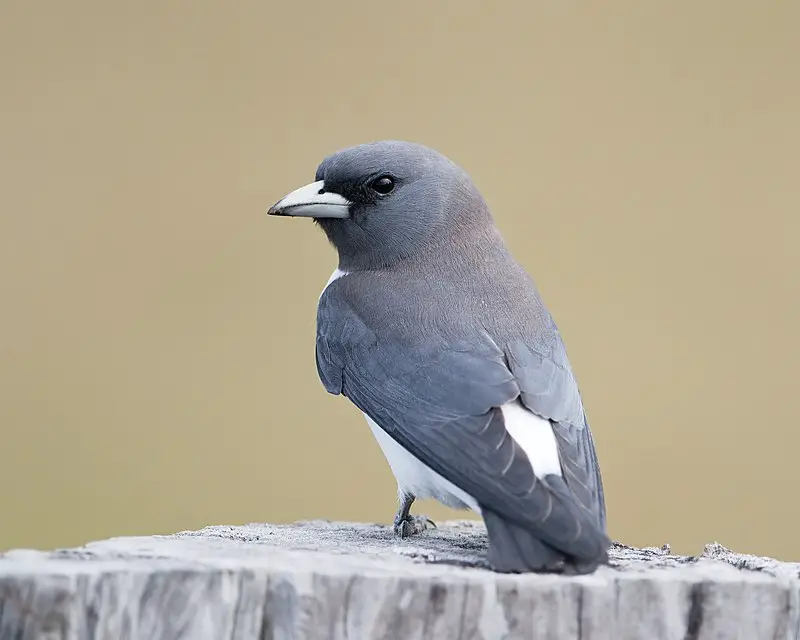
The White-breasted Woodswallow is a medium-sized passerine bird found in the Andaman Islands, Indonesia and Northern Australia.
Its name may be misleading as it does not belong to the family of true swallows but rather belongs to Artamidae which also includes butcherbirds, currawongs and Australian magpie.
These birds are mainly greyish brown with white belly patch and long wings having two pale bars on them.
They feed on insects like ants, beetles etc., captured from foliage or air during flight.
Breeding season for this species starts from October till December when they build their cup shaped nests out of twigs near tree trunks or branches usually high up in trees for protection against predators such as snakes or raptors.
Male woodswallows can often been seen singing loudly while displaying its aerial maneuvering capabilities trying to attract potential mates.
Scientific classification:
| Kingdom | Animalia |
| Phylum | Chordata |
| Class | Aves |
| Order | Passeriformes |
| Family | Artamidae |
| Genus | Artamus |
| Species | A. leucorynchus |
Also Featured In: Brunei birds, Common Townsville Birds
12. Pacific Swallow
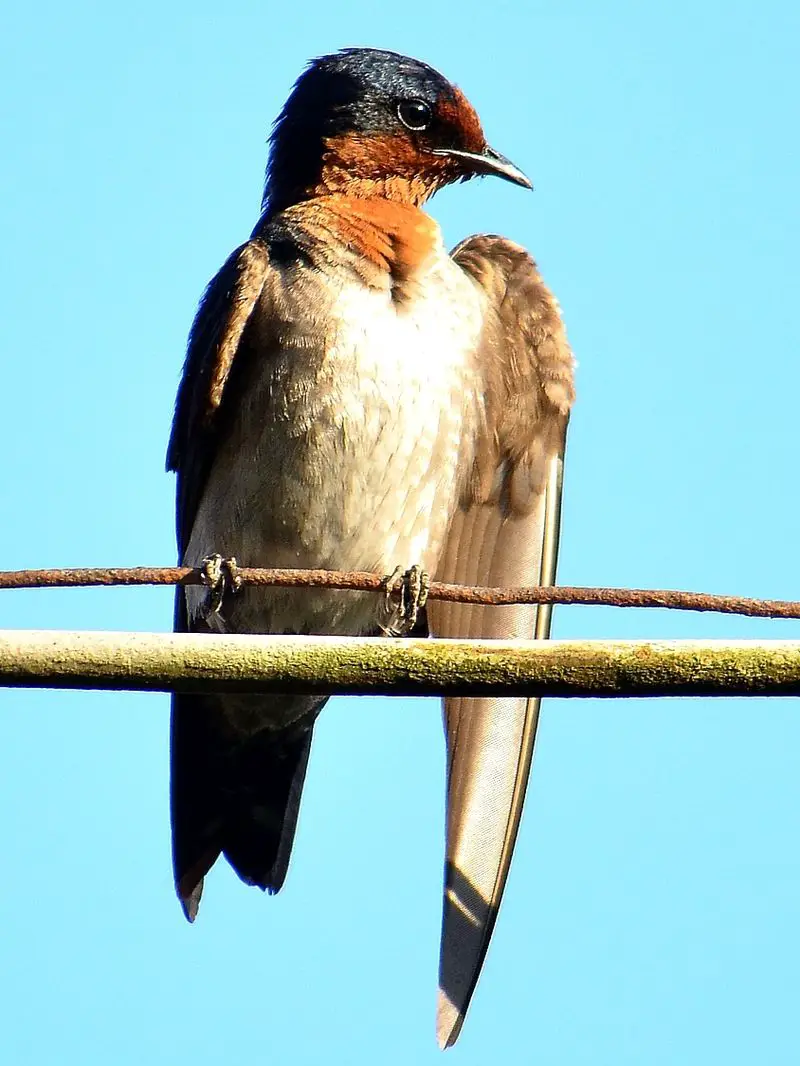
The Pacific Swallow is a small bird with glossy blue-black upperparts and white underparts. It has a short, forked tail and wings that are pointed at the tips.
This swallow typically breeds in tropical southern Asia and the islands of the south Pacific Ocean, although it is becoming more common on forested uplands away from coasts.
During breeding season they construct cup or saucer shaped nests made out of mud pellets in sheltered areas such as rock crevices, eaves or tree hollows.
The diet consists mostly of flying insects which they catch while flying low over water bodies like lakes or rivers during their migratory flights between nesting sites to feeding grounds.
They often travel together in flocks when migrating long distances but can sometimes be seen alone chasing after prey midair.
Scientific classification:
| Kingdom | Animalia |
| Phylum | Chordata |
| Class | Aves |
| Order | Passeriformes |
| Family | Hirundinidae |
| Genus | Hirundo |
| Species | H. tahitica |
Also Featured In: Birds that Live in Tahiti Island, Coastal Birds That Live around Miyako-jima
13. Ashy Drongo
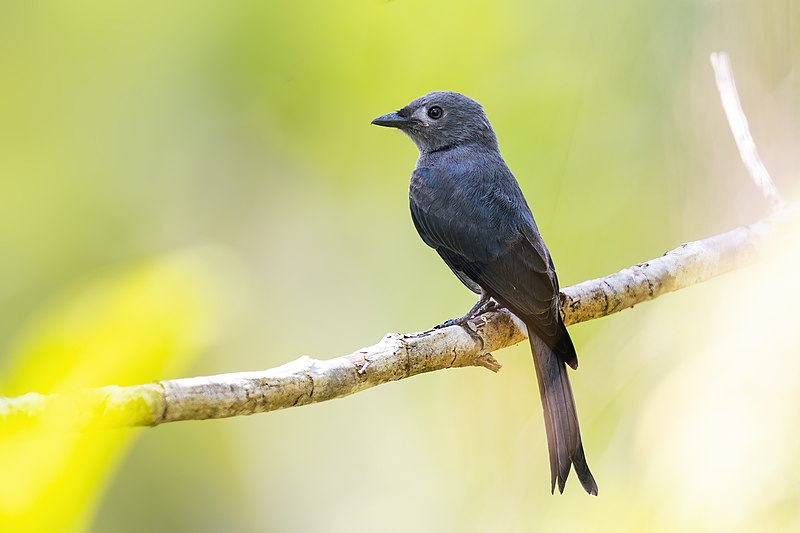
The Ashy Drongo is a species of bird belonging to the drongo family Dicruridae. It has a mainly dark grey plumage and an impressively long, deeply forked tail.
Its distribution across South and Southeast Asia is varied with populations that differ in their shade of grey as well as migration patterns, size or presence of white patches around the eyes.
This medium-sized passerine measures up to 25 cm lengthwise and weighs around 40 gm on average but can reach up to 70 gm at times.
These birds are known for their aerial acrobatics while hunting insects mid-air which makes them quite popular among birders who come from far off places just to catch glimpses of these beautiful creatures in flight.
Scientific classification:
| Kingdom | Animalia |
| Phylum | Chordata |
| Class | Aves |
| Order | Passeriformes |
| Family | Dicruridae |
| Genus | Dicrurus |
| Species | D. leucophaeus |
Also Featured In: Brunei Darussalam Birds, Common Birds in Kerala
14. White-Faced Heron
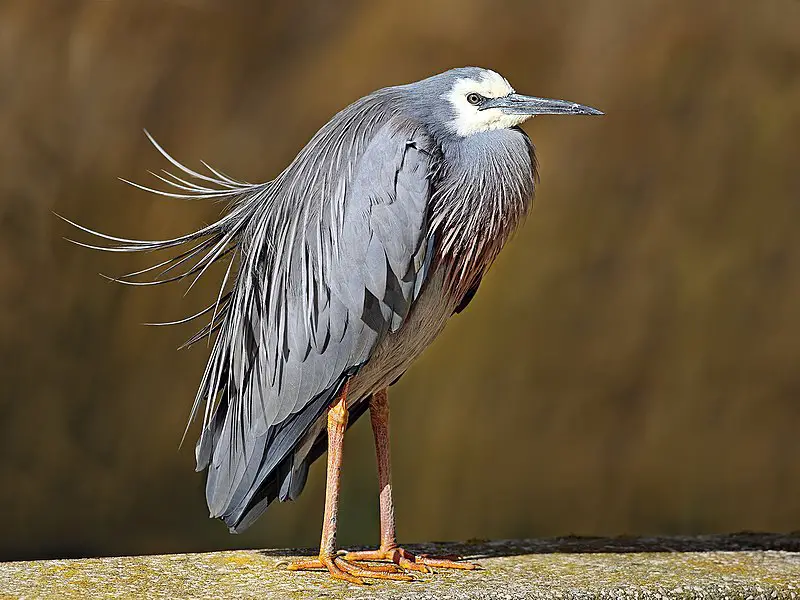
The White-faced Heron is a common sight throughout much of Australasia. With its pale, bluish grey feathers and yellow legs this bird stands out in the crowd.
It can be found on New Guinea, Torres Strait Islands and Indonesia as well as Australia and New Zealand but tends to avoid dry areas. This medium sized heron has one distinct feature – a white face.
Its diet consists mainly of small fish, lizards, frogs insects and crustaceans which it hunts for by wading into shallow water or searching through grasses near wetlands.
In flight they appear graceful with their long neck tucked back against their body giving them an elegant silhouette against the sky.
Their behaviour shows intelligence when finding food sources or evading predators making them interesting creatures to observe in nature.
Scientific classification:
| Kingdom | Animalia |
| Phylum | Chordata |
| Class | Aves |
| Order | Pelecaniformes |
| Family | Ardeidae |
| Genus | Egretta |
| Species | E. novaehollandiae |
Also Featured In: Christmas Island Birds, Birds that Live around Brisbane
15. Green Junglefowl
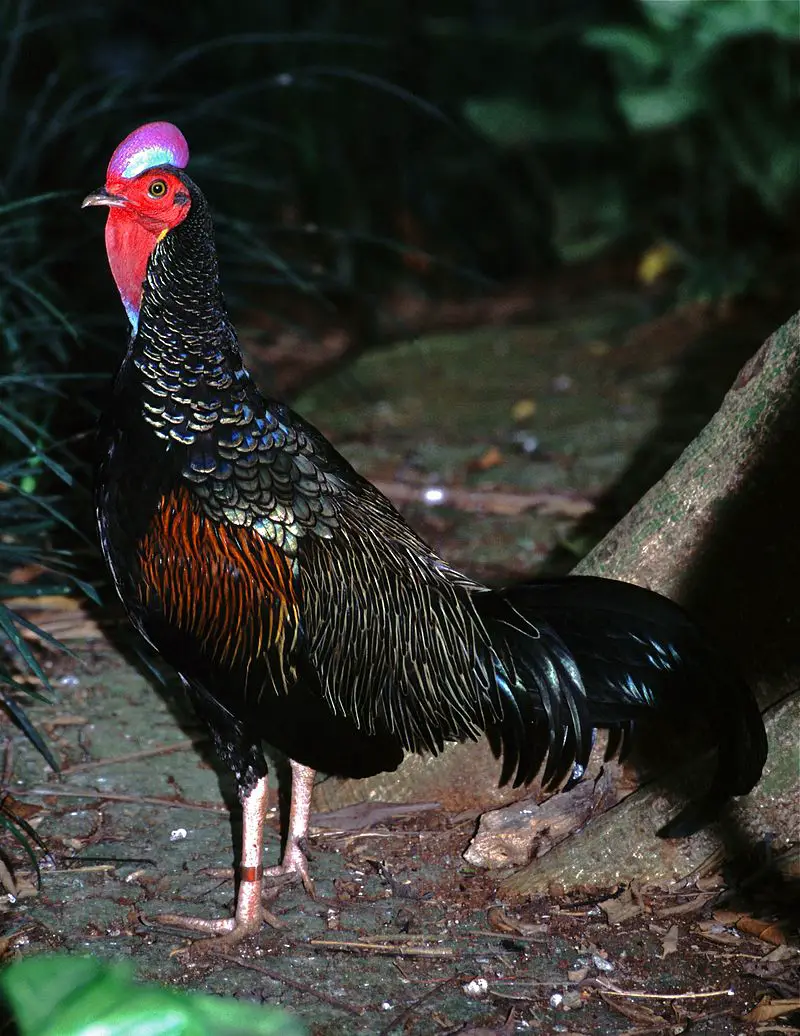
The Green Junglefowl is a species of bird belonging to the pheasant family Phasianidae. It stands up to 75 cm in length and can be found inhabiting dense forests throughout India, Southeast Asia, Indonesia and parts of China.
This beautiful creature has been around for at least four million years making it one of the oldest surviving members of its kind
Its distinct green plumage makes it stand out from other jungle fowls while also making it more vulnerable to predators in its natural environment.
Unfortunately hybridization with domestic chickens has also occurred as reported by some researchers over recent times which could threaten this unique species’ survival if not addressed properly.
Scientific classification:
| Kingdom | Animalia |
| Phylum | Chordata |
| Class | Aves |
| Order | Galliformes |
| Family | Phasianidae |
| Genus | Gallus |
| Species | G. varius |
Also Featured In: Java Birds You Should Know, Common Birds of Indonesia
16. Spotted Kestrel
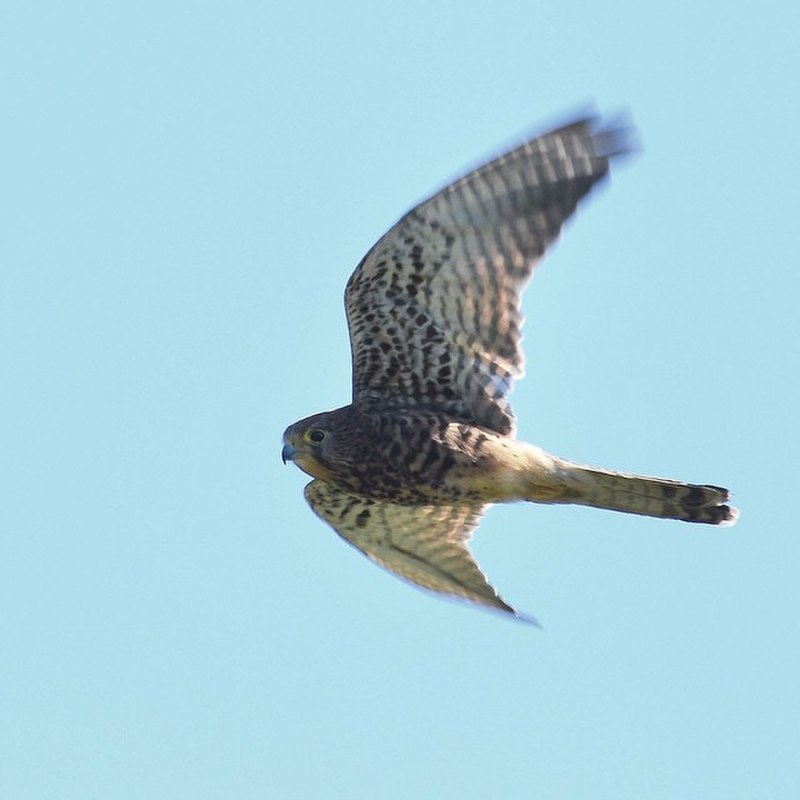
The spotted kestrel, or Moluccan Kestrel, is a species of bird that inhabits grasslands with scattered trees and lightly wooded areas.
It can be found in the Wallacea and Java regions as well as along logging roads where it occasionally penetrates deeper into forests.
They are also known to live within clearings in forested areas. This small raptor has distinctive yellow-brown plumage with black spots on its back and tail feathers which help camouflage them against their surroundings when perched among foliage.
Its diet primarily consists of insects, reptiles such as lizards and rodents like mice.
Scientific classification:
| Kingdom | Animalia |
| Phylum | Chordata |
| Class | Aves |
| Order | Falconiformes |
| Family | Falconidae |
| Genus | Falco |
| Species | F. moluccensis |
Also Featured In: Falcons Species, Birds in Sumba
17. Javan Pond Heron
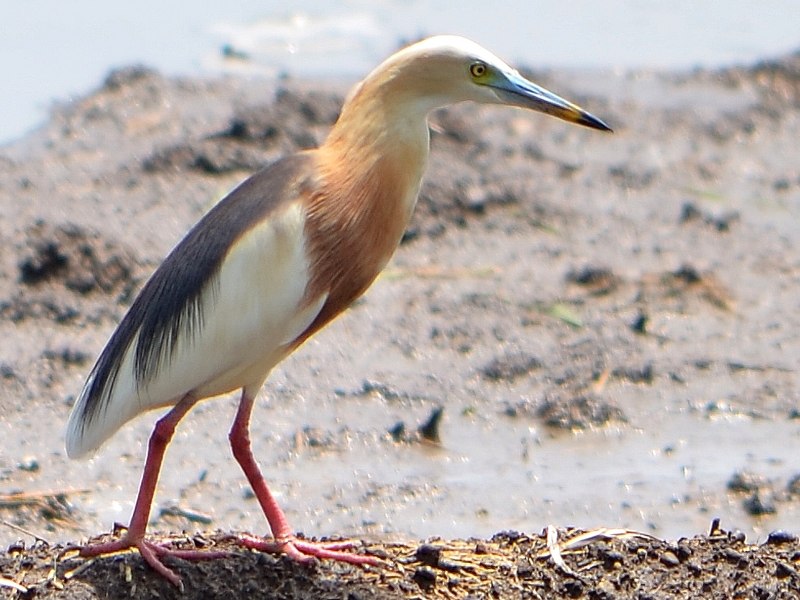
The Javan Pond Heron is a beautiful wading bird that can be found in shallow fresh and salt-water wetlands of Southeast Asia.
It has an overall orange, slaty and white colouring during mating season with yellow bill, black tip on its bill and yellow eyes.
Its length typically measures 45 cm long with white wings. The heron’s diet consists mainly of insects, fish, crabs as well as any other small creatures it may find along the shoreline or water bed where they live.
These birds are usually solitary but can also sometimes gather in groups to hunt for food at dusk when their prey are more active.
They use their keen vision to spot potential prey before quickly darting forward to catch them using their sharp bills.
Scientific classification:
| Kingdom | Animalia |
| Phylum | Chordata |
| Class | Aves |
| Order | Pelecaniformes |
| Family | Ardeidae |
| Genus | Ardeola |
| Species | A. speciosa |
Also Featured In: Herons Species, Birds that Commonly Found in Bali
18. House Swift
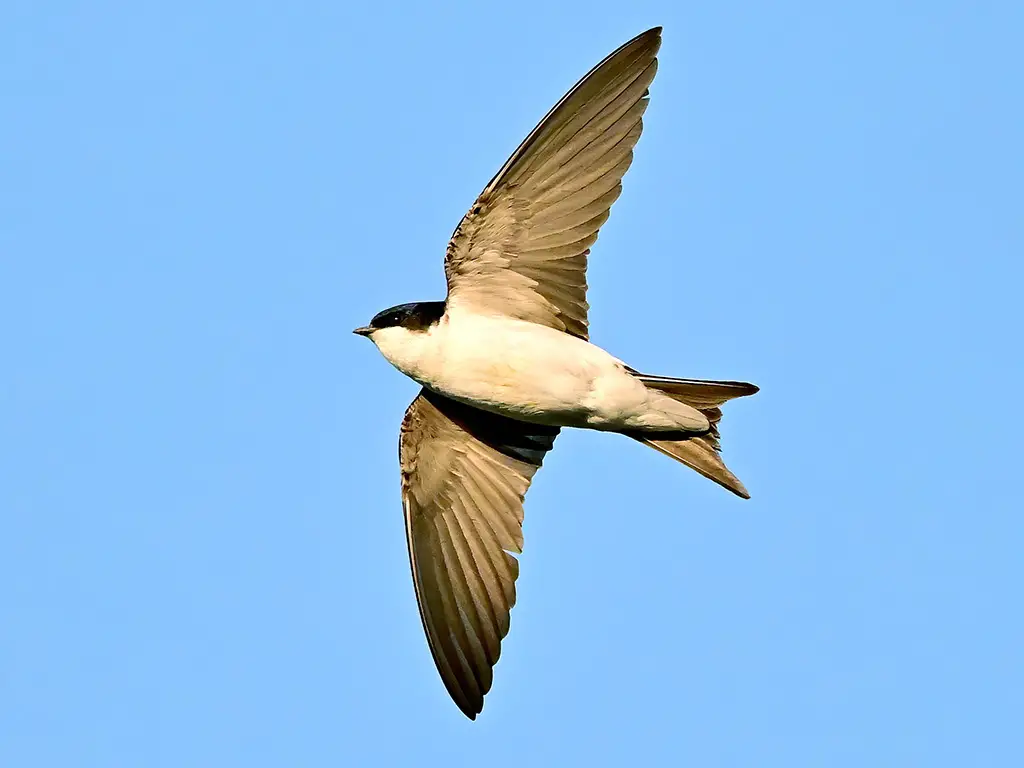
The House Swift is a unique species of bird that can be found in Japan, Nepal, and Southeast Asia.
They have the impressive ability to fly long distances by shutting off one hemisphere of their brain at a time.
In 2012, a House Swift was spotted in Ladner, British Columbia, making it the first sighting of this species in North America.
Although it was once thought to be a subspecies of the Little Swift, it is now recognized as its own distinct species.
These birds are known for their swift and graceful flight patterns and their ability to nest in crevices and holes.
The House Swift is an interesting bird to observe and study, and its unique adaptations make it a fascinating member of the Apodidae family.
Scientific classification:
| Kingdom | Animalia |
| Phylum | Chordata |
| Class | Aves |
| Clade | Strisores |
| Order | Apodiformes |
| Family | Apodidae |
| Genus | Apus |
| Species | A. nipalensis |
Also Featured In: Most Common Taiwan Birds, Birds Commonly Found in Kyoto
19. Brown Honeyeater
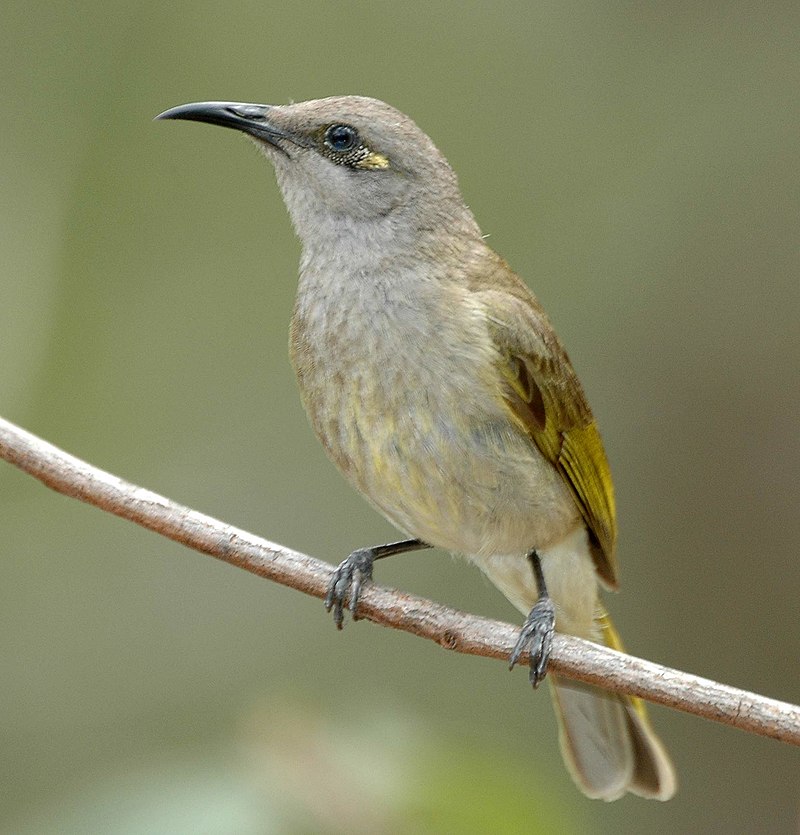
The brown honeyeater is a bird species belonging to the Meliphagidae family. With their brush-tipped tongues, they are adapted for nectar feeding. Honeyeaters are found mainly in Australia, New Guinea, and parts of Indonesia.
However, the brown honeyeater is unique in that it is also found on the island of Bali, making it the only honeyeater species to occur there.
The bird has brown plumage, which helps it to blend in with its surroundings, enabling it to evade detection by predators.
Brown honeyeaters feed on insects and nectar found in the flowers of various plant species. The species is known for its melodious calls and is a common sight in gardens, parks, and open woodlands.
Despite being widespread, the brown honeyeater is not considered endangered.
Scientific classification:
| Kingdom | Animalia |
| Phylum | Chordata |
| Class | Aves |
| Order | Passeriformes |
| Family | Meliphagidae |
| Genus | Lichmera |
| Species | L. indistincta |
Also Featured In: Most Common Western Australia Birds, Birds that Live in Sunshine Coast
20. Scarlet-Headed Flowerpecker
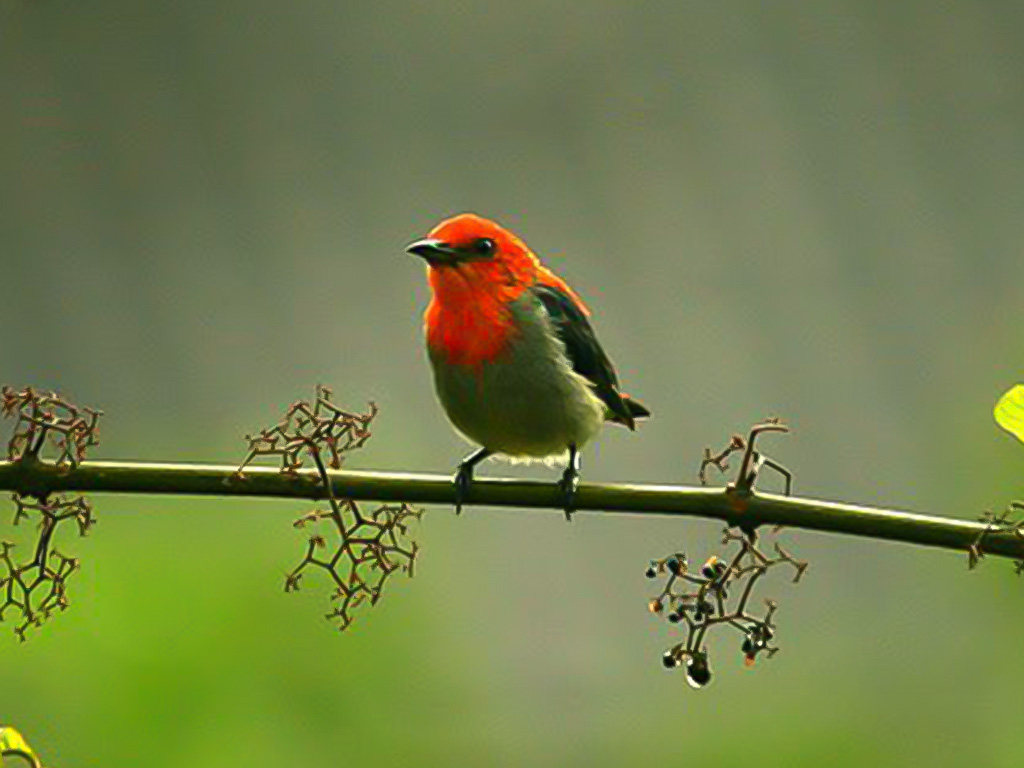
The Scarlet-headed flowerpecker is a bird species found only in Indonesia. It can be seen in open wooded areas, gardens, and mangroves. This bird belongs to the family of Dicaeidae and is known for its striking red head.
Despite being endemic to a few islands in Indonesia, its population is currently stable.
Consequently, the International Union for Conservation of Nature (IUCN) has classified the Scarlet-headed flowerpecker’s conservation status as Least Concern.
Scientific classification:
| Kingdom | Animalia |
| Phylum | Chordata |
| Class | Aves |
| Order | Passeriformes |
| Family | Dicaeidae |
| Genus | Dicaeum |
| Species | D. trochileum |
21. Javan Munia
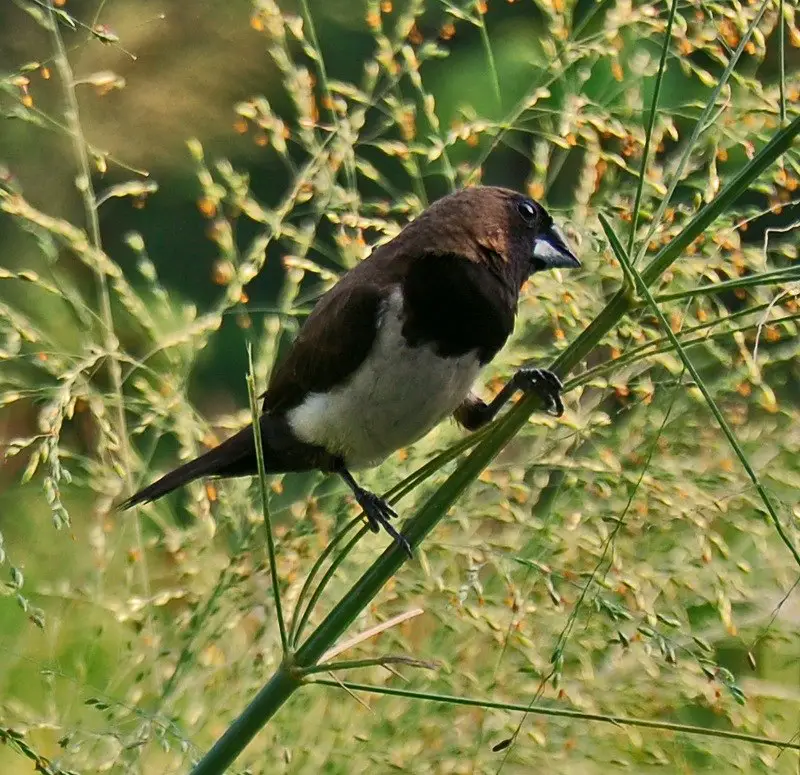
The Javan munia bird is a small finch species that can be found in southern Sumatra, Java, Bali, and Lombok in Indonesia. It has also been introduced in Singapore and the Malay Peninsula.
It prefers subtropical and tropical dry shrubland and grassland habitats. This little bird has been labeled as Least Concern on the IUCN Red List due to its stable population. Interestingly, it feeds on algae, setting it apart from other bird species.
With its vibrant colors and small size, the Javan munia is a unique and beautiful part of Indonesia’s avian wildlife.
Scientific classification:
| Kingdom | Animalia |
| Phylum | Chordata |
| Class | Aves |
| Order | Passeriformes |
| Family | Estrildidae |
| Genus | Lonchura |
| Species | L. leucogastroides |
Also Featured In: Birds that Found in Sumatra,
22. Black-Winged Myna

The black-winged myna, also called the black-winged starling or the white-breasted starling, is a species of bird belonging to the starling family. It is found only in Indonesia and comes in three recognized subspecies.
The nominate race thrives on much of the island of Java, while tricolor is confined to southeast Java. Finally, tertius dwells in some parts of Bali and Lombok.
The black-winged myna has incredibly striking plumage with its jet-black wings and a white breast.
It is an omnivore, meaning it feeds on various foods like insects, fruits, and seeds.
Unfortunately, like most species, the black-winged myna is threatened by the destruction of its natural habitat and overexploitation, making it essential to conserve and protect its population.
Scientific classification:
| Kingdom | Animalia |
| Phylum | Chordata |
| Class | Aves |
| Order | Passeriformes |
| Family | Sturnidae |
| Genus | Acridotheres |
| Species | A. melanopterus |
23. Streaked Weaver
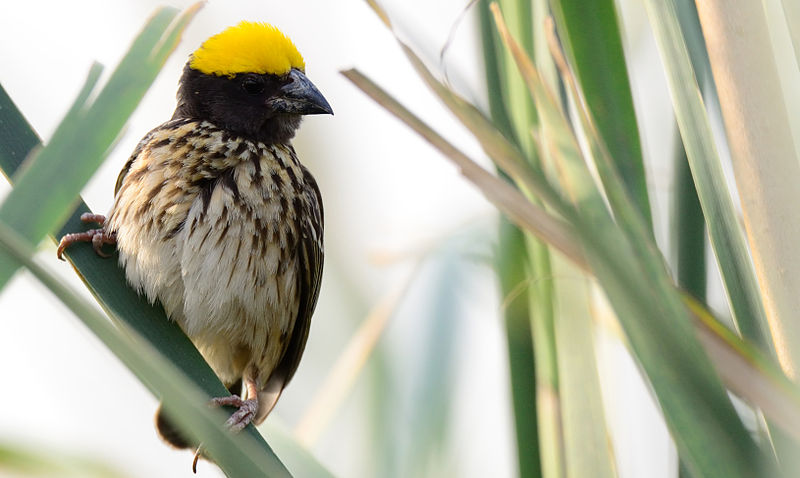
The streaked weaver is a bird species that can be found in several countries across South Asia and Southeast Asia. It is closely related to the more commonly seen baya weaver and looks quite similar, but with distinguishing streaks on its plumage.
These birds are not as plentiful as their baya cousins.
The streaked weaver has been recorded in countries such as Bangladesh, Bhutan, Cambodia, China, Egypt, India, Indonesia, Myanmar, Nepal, Pakistan, Singapore, Thailand, Vietnam, and has been introduced in Qatar and United Arab Emirates (UAE).
Overall, the streaked weaver is a fascinating bird species that adds to the remarkable biodiversity of the regions where it can be found.
Scientific classification:
| Kingdom | Animalia |
| Phylum | Chordata |
| Class | Aves |
| Order | Passeriformes |
| Family | Ploceidae |
| Genus | Ploceus |
| Species | P. manyar |
24. Striated Swallow
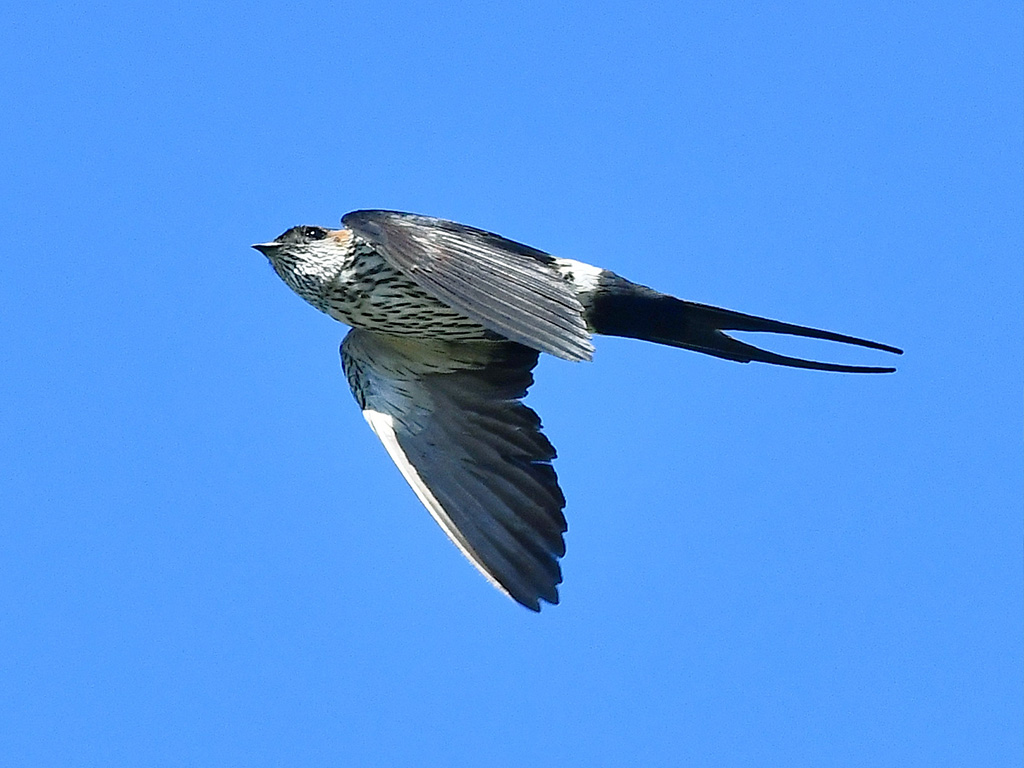
The Striated swallow bird is commonly found in Southeast Asia, Taiwan, and northeastern India. It prefers open areas with clearings and cultivation, especially hilly regions.
It has blue upperparts and a deeply forked tail, measuring 19 cm in length. A reddish collar distinguishes it from other similar species. Formerly, it was considered a subspecies of the Red-rumped swallow.
These agile birds are often seen darting through the air, catching insects on the wing. Their diet mainly consists of flying insects, which they catch using their beaks.
Often found in small flocks, they build nests made of mud pellets, usually under the eaves of buildings or other man-made structures.
These birds are an important part of the ecosystem, helping to control insect populations and serving as important pollinators.
Scientific classification:
| Kingdom | Animalia |
| Phylum | Chordata |
| Class | Aves |
| Order | Passeriformes |
| Family | Hirundinidae |
| Genus | Cecropis |
| Species | C. striolata |
Also Featured In: Most Common Birds in Negros, Palawan Island Birds
25. Grey-Rumped Treeswift
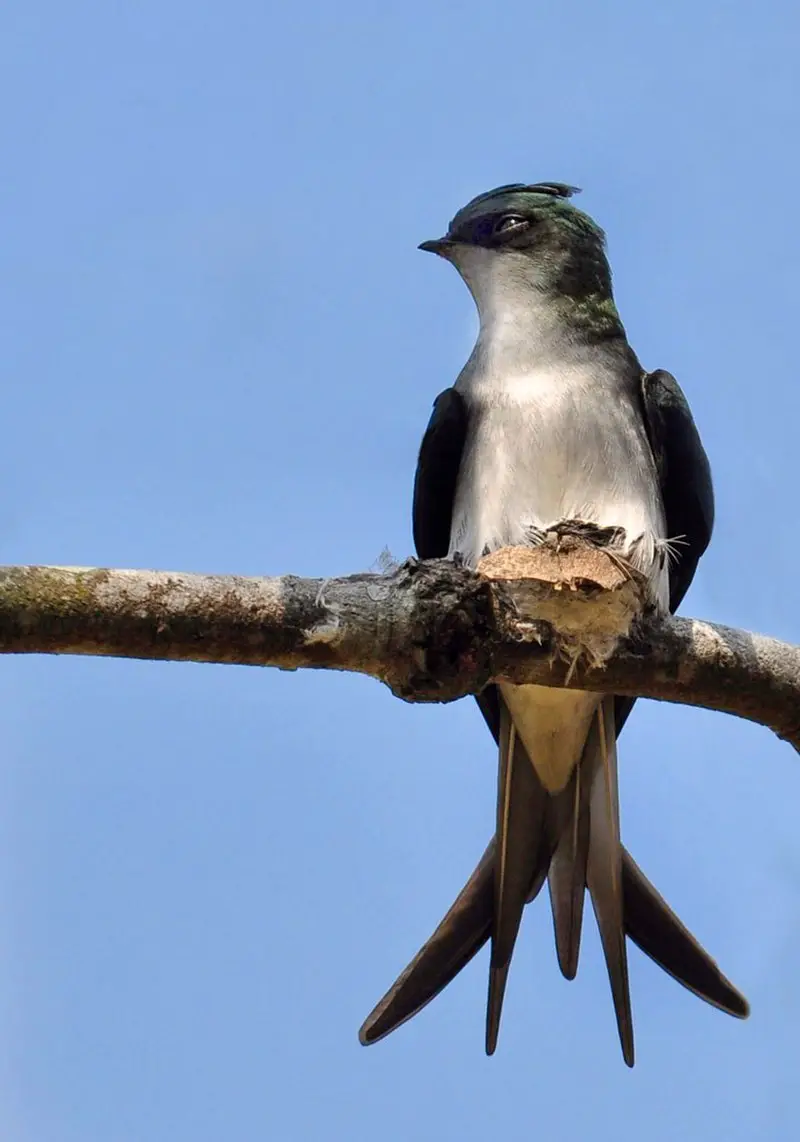
The Grey-rumped treeswift is a type of bird belonging to the Hemiprocnidae family. It is closely related to true swifts, but is different in that it prefers an arboreal lifestyle, perching on trees and power lines.
Unlike other swifts, the Grey-rumped treeswift has a distinct grey coloring on its rear end. It is one of only four species in the Hemiprocnidae family. This bird is often seen on pylons and high-tension power transmission lines.
Despite its name, the Grey-rumped treeswift is not actually related to the common swift. It has a unique physiology and behavior that sets it apart from other avian species.
The Grey-rumped treeswift is a fascinating bird that birdwatchers and nature enthusiasts alike should look out for.
Scientific classification:
| Kingdom | Animalia |
| Phylum | Chordata |
| Class | Aves |
| Clade | Strisores |
| Order | Apodiformes |
| Family | Hemiprocnidae |
| Genus | Hemiprocne |
| Species | H. longipennis |
Also Featured In: Birds that Live in Kuala Lumpur,
26. Dark-Backed Imperial Pigeon
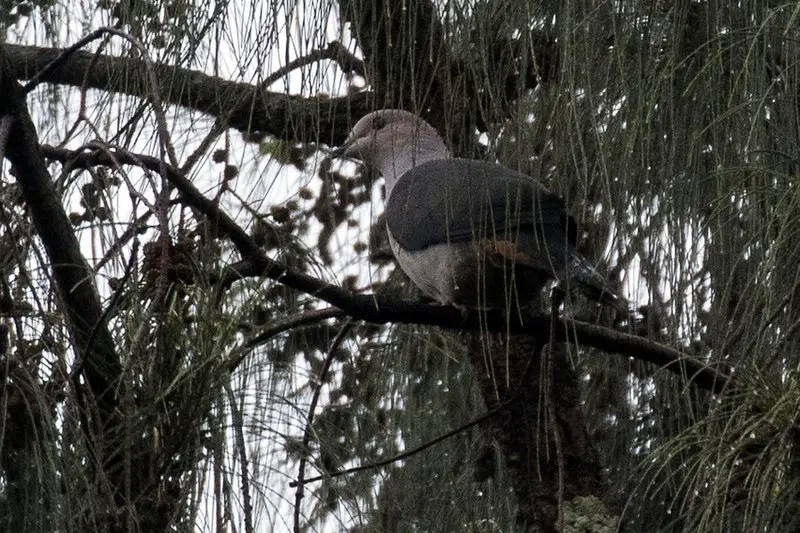
The Dark-backed imperial pigeon is a unique bird species belonging to the family Columbidae. It can only be found in the Lesser Sunda Islands.
This bird species prefers subtropical or tropical moist lowland forests and subtropical or tropical moist montane forests as their natural habitats.
They are known to have dark-colored backs and are commonly referred to as the Dark-backed imperial pigeon.
This bird species has a distinct appearance and is considered an excellent example of biodiversity in the islands.
Their unique habitat preferences and limited distribution make them an important species to protect.
Although not much is known about their behavior or ecology, the Dark-backed imperial pigeon serves as a reminder of the incredible diversity of species present in our world.
Scientific classification:
| Kingdom | Animalia |
| Phylum | Chordata |
| Class | Aves |
| Order | Columbiformes |
| Family | Columbidae |
| Genus | Ducula |
| Species | D. lacernulata |
27. Lesser Shortwing
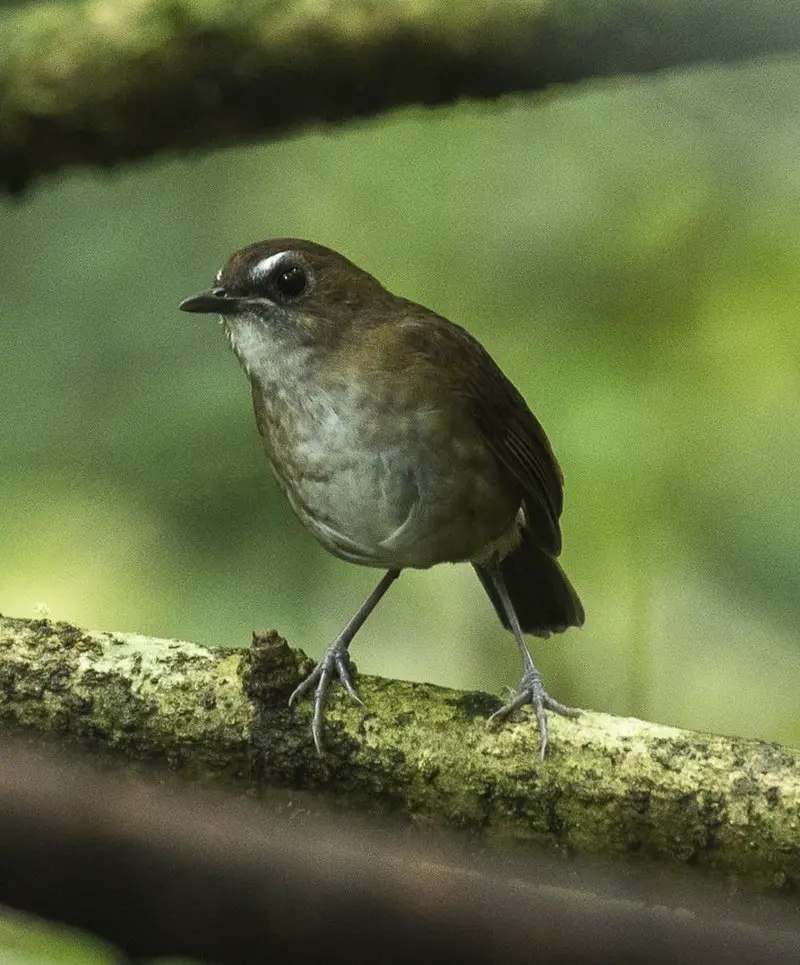
The Lesser Shortwing bird is a type of chat that belongs to the Muscicapidae family. Native to south-eastern Asia, the bird can be found in regions such as Sumatra, Java, and the Lesser Sundas.
The bird’s natural habitat includes subtropical or tropical moist montane forests. Its scientific name is Brachypteryx leucophris, and it is known for its small size and attractive appearance.
Although it shares a similar name with the Short-winged Tailor bird, their appearances are vastly different.
The Lesser Shortwing has a beautiful chestnut-brown upper body with a distinctive white belly.
Despite being classified as a “least concern” species, the population of the Lesser Shortwing has been decreasing steadily.
There are several conservation efforts in place to protect the bird’s natural habitat and its existence to ensure that it continues to thrive in the future.
Scientific classification:
| Kingdom | Animalia |
| Phylum | Chordata |
| Class | Aves |
| Order | Passeriformes |
| Family | Muscicapidae |
| Genus | Brachypteryx |
| Species | B. leucophris |
Also Featured In: Wetar Island Birds You Need to Know,
28. Olive-Backed Tailorbird
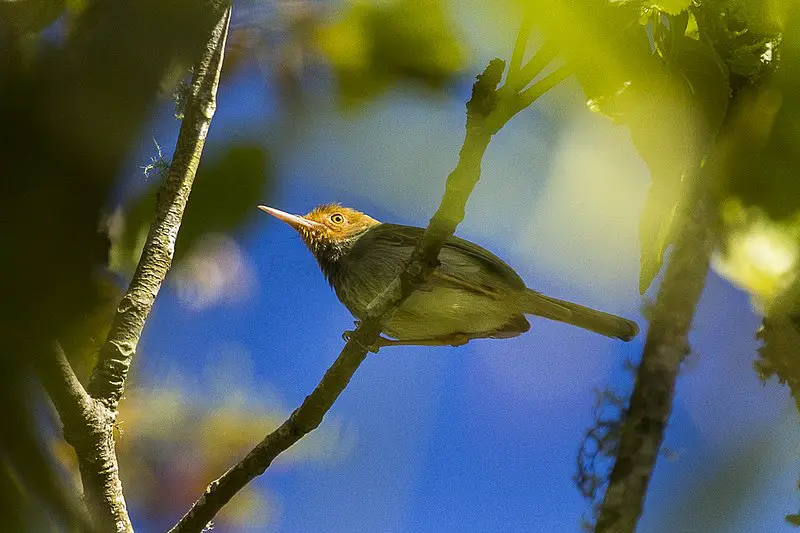
The olive-backed tailorbird is a small passerine bird found only on a few islands in Indonesia, including Java, Madura Island, Bali, and Lombok.
Although once classified as an “Old World warbler,” it is now considered part of the Cisticolidae family.
This bird is known for its bright green back and white belly, as well as its unique ability to sew leaves together to create nests. Its small size and elusive nature make it a difficult bird to spot in the wild.
Despite being relatively unknown, the olive-backed tailorbird plays an important role in its ecosystem as a seed disperser and insect-eater.
Habitat destruction and fragmentation pose a threat to the survival of this species, making conservation efforts crucial for its continued existence.
Scientific classification:
| Kingdom | Animalia |
| Phylum | Chordata |
| Class | Aves |
| Order | Passeriformes |
| Family | Cisticolidae |
| Genus | Orthotomus |
| Species | O. sepium |
29. Wedge-Tailed Green Pigeon

The Wedge-tailed green pigeon, also known as Kokla green pigeon, is a bird from the Columbidae family. It has a distinctive wedge-shaped tail and greenish yellow feathers.
The male has maroon on its back and scapulars, with an orange-rufous tint on its crown. The female lacks these features.
This species is indigenous to the Indian Subcontinent and Southeast Asia, including Bangladesh, Bhutan, Cambodia, and India.
It is a common sight in the region and can be found in forests, gardens, and cities alike. These birds generally feed on fruits and grains and are known to form flocks.
Interestingly, the Wedge-tailed green pigeon is considered one of the few bird species that are long-distance frugivores, as their diet mainly consists of fruit from trees that are several hundred meters apart.
Scientific classification:
| Kingdom | Animalia |
| Phylum | Chordata |
| Class | Aves |
| Order | Columbiformes |
| Family | Columbidae |
| Genus | Treron |
| Species | T. sphenurus |
Also Featured In: Birds that Commonly Found in Andhra Pradesh,
30. Flores Green Pigeon
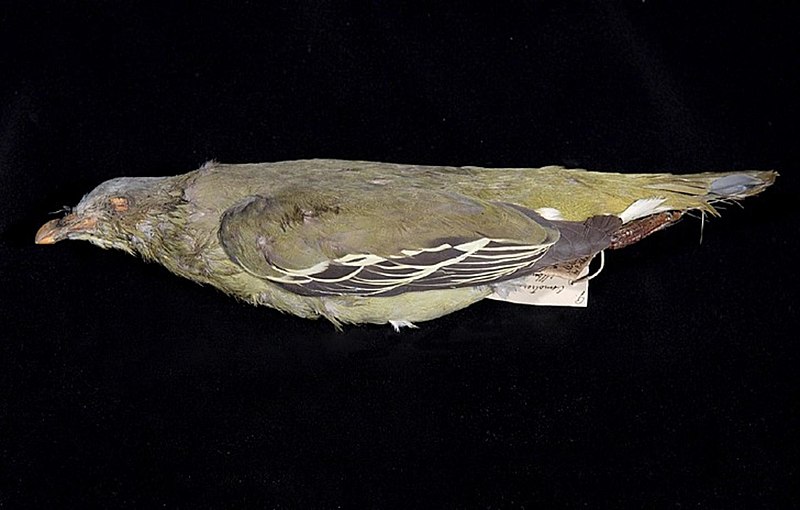
The Flores green pigeon is a unique species of bird found only in the Lesser Sunda Islands of Indonesia. Its natural habitats include subtropical or tropical dry forests, moist lowland forests and dry savannas.
These birds are threatened by habitat loss due to human activities such as deforestation. They are known for their beautiful green plumage and are a sight to behold in their natural habitat.
Despite being a lesser-known species, the Flores green pigeon is an important part of the ecosystem and plays a crucial role in pollination and seed dispersal.
Efforts are being made to protect and conserve their habitats to prevent their extinction.
It is important for humans to recognize the value of all animal species and to work towards preserving their habitats to ensure their survival for generations to come.
Scientific classification:
| Kingdom | Animalia |
| Phylum | Chordata |
| Class | Aves |
| Order | Columbiformes |
| Family | Columbidae |
| Genus | Treron |
| Species | T. floris |
Also Featured In: Birds that Live near Flores Island,
31. Pale-Headed Munia
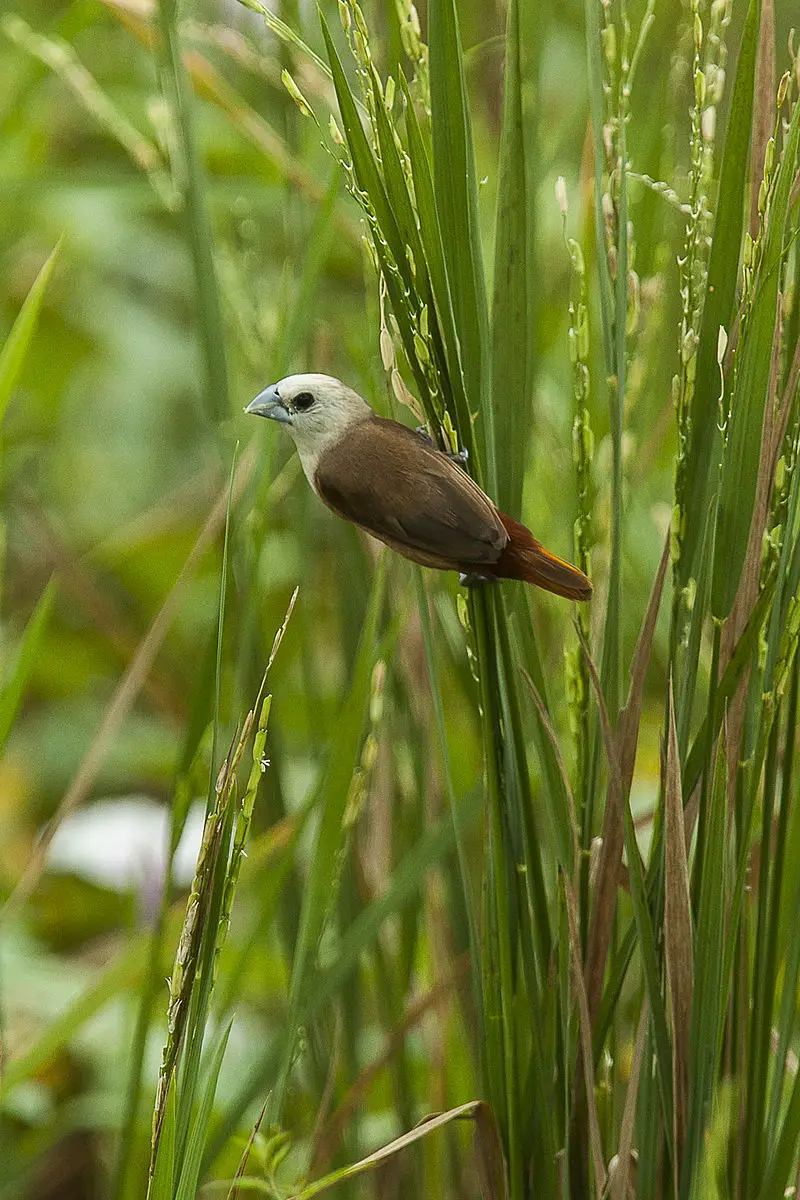
The Pale-headed munia is a finch species found in Indonesia, and its habitat includes artificial landscapes, shrublands, and grasslands. The bird has been evaluated as Least Concern in terms of its conservation status.
According to scientific research, it is believed that Estrildinae, the subfamily to which the Pale-headed munia belongs, might have originated in India and then dispersed later.
Scientific classification:
| Kingdom | Animalia |
| Phylum | Chordata |
| Class | Aves |
| Order | Passeriformes |
| Family | Estrildidae |
| Genus | Lonchura |
| Species | L. pallida |
32. White-Shouldered Triller
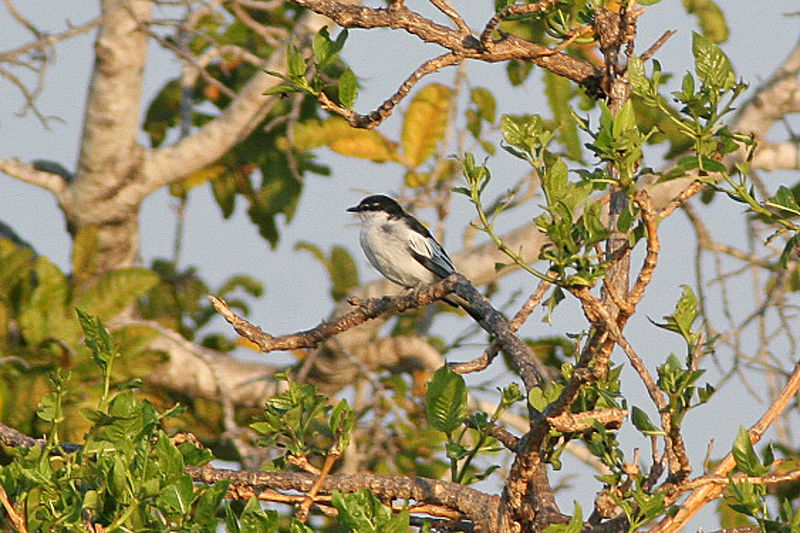
The white-shouldered triller is a small passerine bird found in Indonesia and East Timor. It belongs to the cuckoo-shrike family Campephagidae and is closely related to the white-winged triller of Australia and New Guinea.
It has a length of 17 centimeters and a distinctive white shoulder patch. They have a small but sharp beak for catching insects. The white-shouldered triller prefers to live in forested areas, where it feeds on insects and sometimes berries.
They have a melodious song and are known for their acrobatic aerial displays. Their population size and overall conservation status are not yet well documented, but they can be subject to habitat loss and fragmentation.
Observation and documentation of these birds are necessary to understand their ecological role and provide conservation measures for their survival.
Scientific classification:
| Kingdom | Animalia |
| Phylum | Chordata |
| Class | Aves |
| Order | Passeriformes |
| Family | Campephagidae |
| Genus | Lalage |
| Species | L. sueurii |
33. Scaly-Crowned Honeyeater
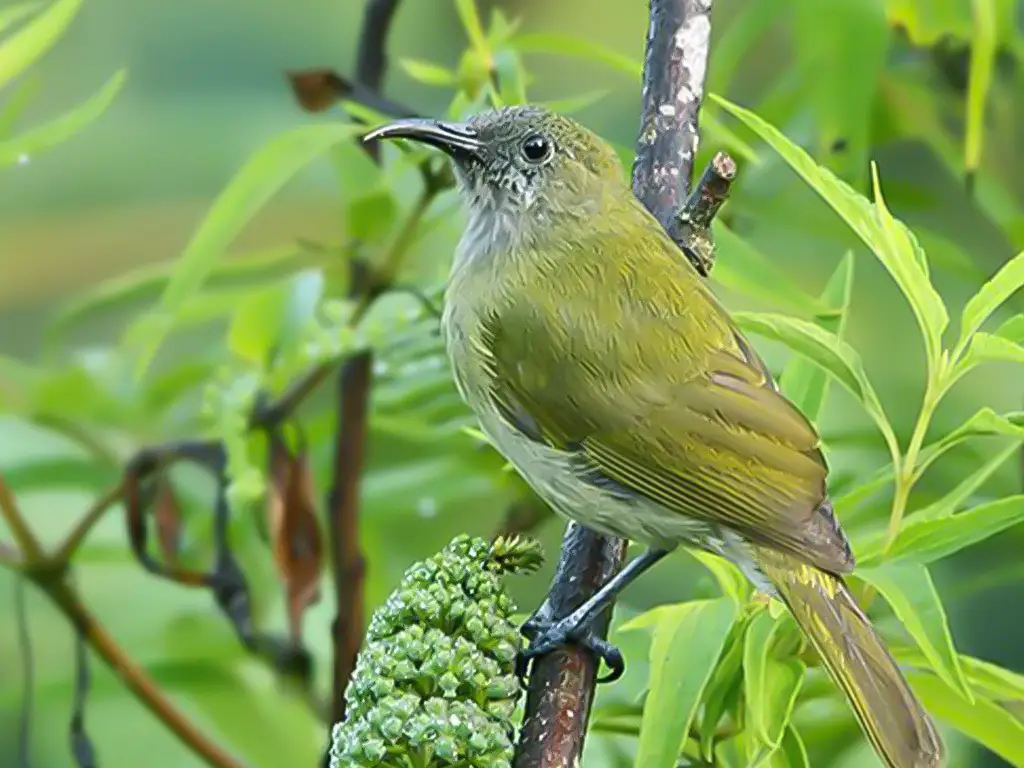
The Scaly-crowned honeyeater, also known as Sugomel lombokium, is a bird species that belongs to the Meliphagidae family. It can be found exclusively in Indonesia, specifically in the Lesser Sunda Islands.
Its preferred habitats are subtropical and tropical moist lowland forests and subtropical or tropical moist montane forests. This species of bird used to be classified as Lichmera lombokia until 2022 when it was renamed.
The Scaly-crowned honeyeater is a unique bird species with its crown covered in scales, hence its name. It has a distinct appearance and is a treat to observe if you’re lucky enough to catch a glimpse of one.
Scientific classification:
| Kingdom | Animalia |
| Phylum | Chordata |
| Class | Aves |
| Order | Passeriformes |
| Family | Meliphagidae |
| Genus | Sugomel |
| Species | S. lombokium |
34. Sunset Lorikeet
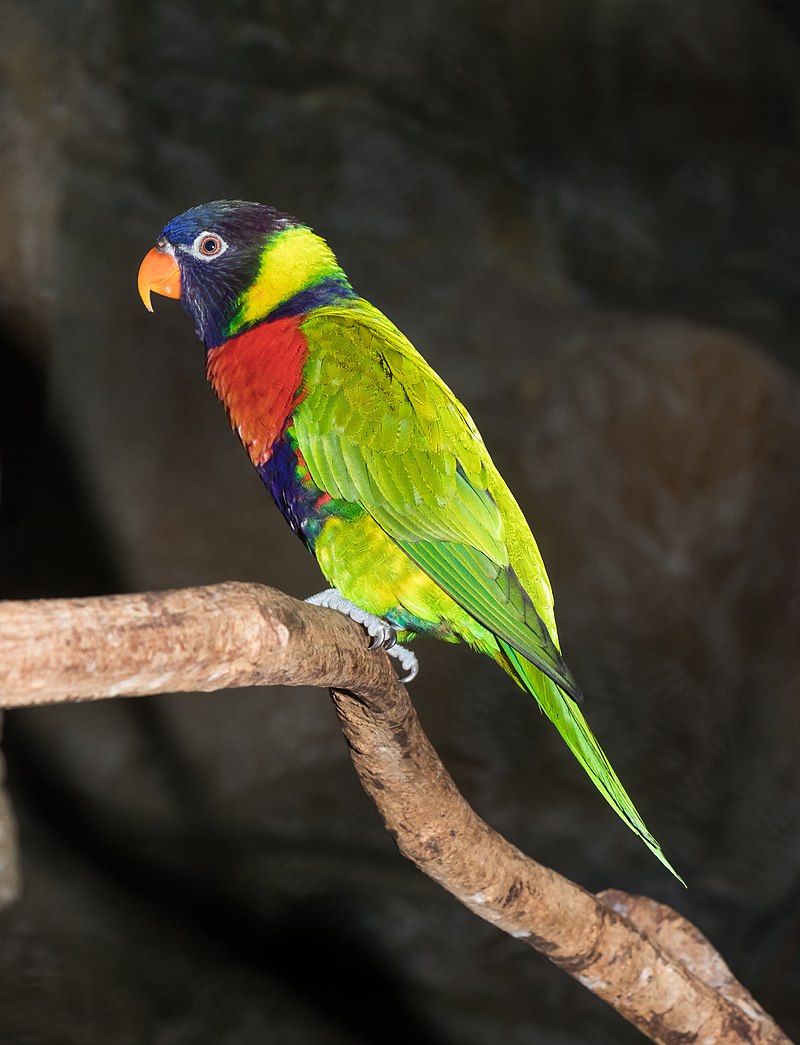
The Sunset lorikeet is a charming parrot species with a scarlet chest that is native to the Indonesian islands including Bali, Lombok, Sumbawa, Tanah Jampea, and Kalaotoa.
Interestingly, it was previously considered a sub-species of the rainbow lorikeet, but after extensive research in 1997, it was recognized as a separate species. These colorful birds are known for their striking appearance and exceptional flying skills.
They are characterized by their playful and curious nature and are quite popular as pets due to their affectionate personalities.
The Sunset lorikeet primarily feeds on nectar and fruits which also make up a significant part of their diet. As with many other parrots, they are threatened by habitat loss and hunting for the pet trade.
Conservation efforts are underway to ensure their survival in the wild.
Scientific classification:
| Kingdom | Animalia |
| Phylum | Chordata |
| Class | Aves |
| Order | Psittaciformes |
| Family | Psittaculidae |
| Genus | Trichoglossus |
| Species | T. forsteni |
35. Lemon-Bellied White-Eye
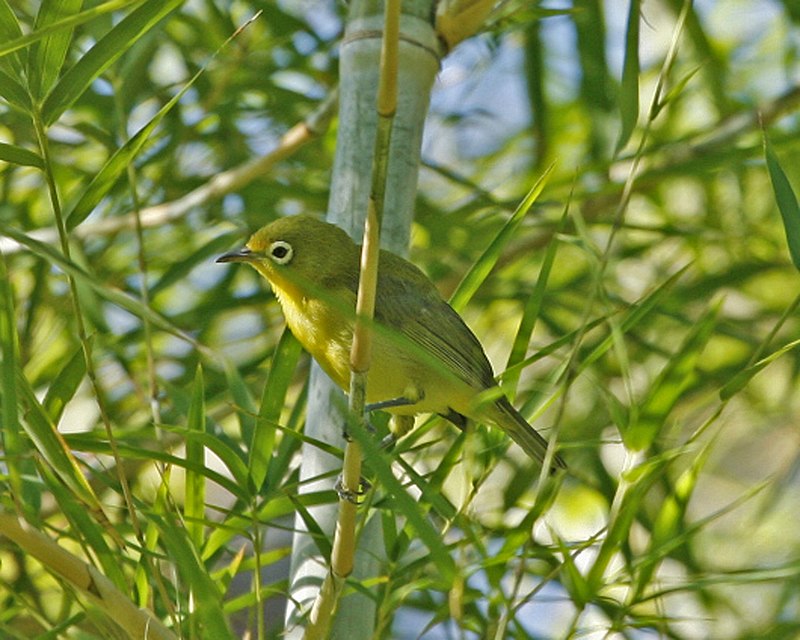
The Lemon-bellied White-eye bird, scientifically known as Zosterops chloris, is a type of bird belonging to the family Zosteropidae. This particular species can only be found in Indonesia and is generally present in smaller islands, except for some of the biggest islands in the country.
This bird has a distinct appearance, with a lemon-colored belly and white eyes that make it stand out against the green trees and foliage it often frequents.
Despite its limited range, this bird has managed to adapt and survive in the Indonesian archipelago. It is a common sight for birdwatchers in the area who come to observe its unique characteristics and behavior in their natural habitat.
Despite being relatively unknown to many people outside of Indonesia, the Lemon-bellied White-eye bird is an important contributor to the country’s rich and diverse avian fauna.
Scientific classification:
| Kingdom | Animalia |
| Phylum | Chordata |
| Class | Aves |
| Order | Passeriformes |
| Family | Zosteropidae |
| Genus | Zosterops |
| Species | Z. chloris |
36. Blue-Cheeked Flowerpecker
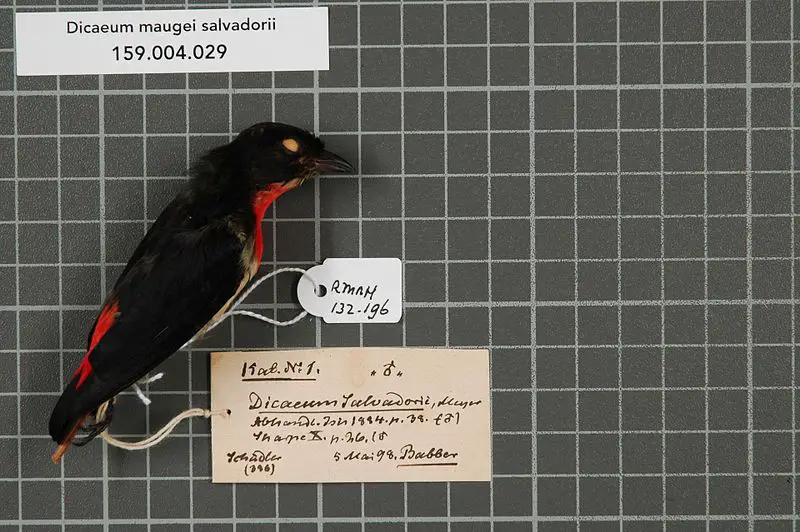
The Blue-cheeked flowerpecker, also known as the Red-chested flowerpecker, is a member of the Dicaeidae family of birds. This species is found on Timor island in the Lesser Sundas.
Their natural habitats include forests with moist, subtropical or tropical conditions. The Blue-cheeked flowerpecker is a small bird that measures just a few inches long.
They have a distinctive blue and black coloration on their cheeks and a patch of red on their chest.
Their diet primarily consists of nectar and insects. These tiny birds play an important role in pollinating flowers while feeding on nectar. They also help to control insect populations in their ecosystems.
Despite their small size, the Blue-cheeked flowerpecker is a fascinating species of bird that is essential to the ecological balance of their habitat.
Scientific classification:
| Kingdom | Animalia |
| Phylum | Chordata |
| Class | Aves |
| Order | Passeriformes |
| Family | Dicaeidae |
| Genus | Dicaeum |
| Species | D. maugei |